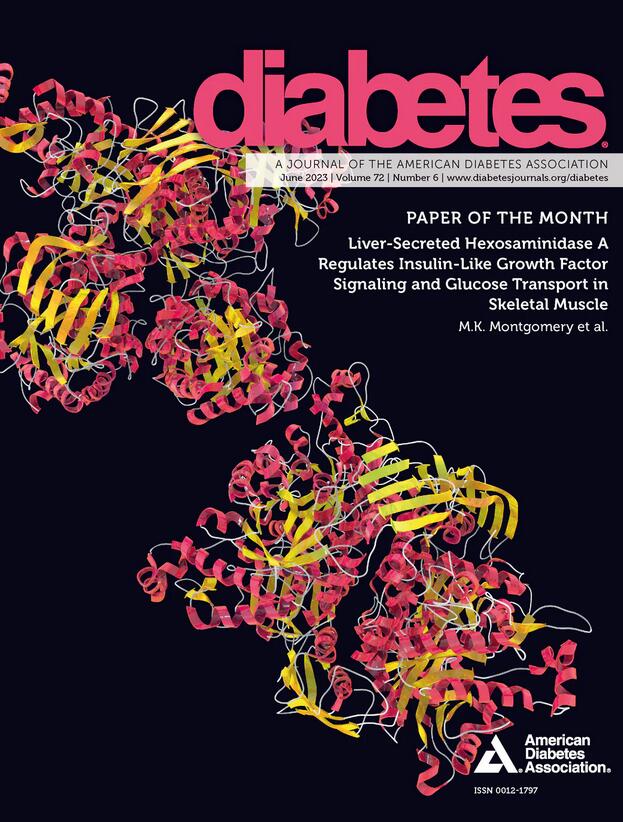23-PUB: Reduction of Residual Lipid Risk in Patients with Type 2 Diabetes and Mixed Dyslipidemia Treated with a Fixed-Dose Combination of Atorvastatin/Fenofibrate
IF 6.2
1区 医学
Q1 ENDOCRINOLOGY & METABOLISM
引用次数: 0
Abstract
Introduction and Objective: The persistence of a high cardiovascular risk not dependent on LDL-C levels constitutes the residual cardiovascular risk of lipid origin (RLR). Lipid-lowering treatment does not always consider the modification of RLR. The present study aimed to evaluate the changes in RRL profile in patients with T2D and dyslipidemia treated with a fixed-dose combination (FDC) of Atorvastatin/Fenofibrate. Methods: A phase IIIb, randomized, prospective, double-blind, multicenter study in the Mexican population with diagnosis of T2D and mixed dyslipidemia. Patients were randomized to the Atorvastatin/Fenofibrate 20 mg/160 mg or Atorvastatin 20 mg once daily for four months. As part of the RLR evaluation, Triglycerides/HDL-C, residual cholesterol, Total cholesterol/HDL-C, and the triglycerides-to-glucose index (TyG) were estimated. Student's t-test and McNemar test (differences within groups) χ2, and independent samples Student's t-test were applied. Results: We included 65 patients with an average age of 56.8 ± 10.4 years. After two months of follow-up, there was a triglycerides reduction of -132.7 ± 145.3 mg/dL in the FDC group and of -68.7 ± 75.7 mg/dL with Atorvastatin therapy, while for the fourth month, the reduction was -138.3 ± 123.7 mg/dL and -60.5 ± 80.1 mg/dL, respectively. When evaluating RLR, both groups experienced a reduction in this profile, after 2 and 4 months of evaluation. However, when comparing the mean change reductions between groups of Triglycerides/HDL-C ratio (-3.9 vs -1.3, p=0.020), residual cholesterol (-19 vs -9.4, p= 0.018), and TyG (-0.7 vs -0.2, p=0.002) a superior outcome was found in FDC compared with the monotherapy group. Conclusions: Patients receiving Atorvastatin/Fenofibrate FDC had a better reduction than monotherapy in non-LDL cholesterol-dependent RRL markers, which translates to a decrease in overall cardiovascular risk for this treatment group. Disclosure J.G. Sander-Padilla: Employee; Laboratorios Silanes. L.A. Lugo-Sánchez: Employee; Laboratorios Silanes S.A. de C.V. K.F. Rios-Brito: Employee; Laboratorios Silanes S.A. de C.V. K.E. Rodriguez-Rocandio: Employee; Laboratorios Silanes S.A. de C.V. M.M. Arguedas: Employee; Laboratorios Silanes S.A. de C.V. D. Flores-Huanosta: Employee; Laboratorios Silanes. I.C. Rodriguez-Vazquez: Employee; Laboratorios Silanes S.A. de C.V. J. Gonzalez-Canudas: Employee; Silanes SA CV. Y. Romero: Employee; Laboratorios Silanes. Funding Laboratorios Silanes23-PUB: 阿托伐他汀/非诺贝特固定剂量复方制剂可降低2型糖尿病和混合型血脂异常患者的残余血脂风险
导言和目的:与低密度脂蛋白胆固醇(LDL-C)水平无关的高心血管风险的持续存在构成了血脂源性残余心血管风险(RLR)。降脂治疗并不总是考虑改变 RLR。本研究旨在评估接受阿托伐他汀/非诺贝特固定剂量联合用药(FDC)治疗的 T2D 和血脂异常患者的 RLR 变化情况。研究方法在确诊患有 T2D 和混合型血脂异常的墨西哥人群中开展一项 IIIb 期、随机、前瞻性、双盲、多中心研究。患者随机接受阿托伐他汀/非诺贝特 20 毫克/160 毫克或阿托伐他汀 20 毫克治疗,每日一次,为期四个月。作为RLR评估的一部分,对甘油三酯/高密度脂蛋白胆固醇、残余胆固醇、总胆固醇/高密度脂蛋白胆固醇和甘油三酯-葡萄糖指数(TyG)进行了估算。采用学生 t 检验和 McNemar 检验(组内差异)χ2,以及独立样本学生 t 检验。结果共纳入 65 名患者,平均年龄(56.8 ± 10.4)岁。随访两个月后,FDC 组甘油三酯降低了 -132.7 ± 145.3 mg/dL,阿托伐他汀治疗组降低了 -68.7 ± 75.7 mg/dL,而第四个月的降幅分别为 -138.3 ± 123.7 mg/dL 和 -60.5 ± 80.1 mg/dL。在评估 RLR 时,两组患者在 2 个月和 4 个月后的 RLR 都有所下降。然而,在比较甘油三酯/高密度脂蛋白胆固醇比率(-3.9 vs -1.3, p=0.020)、残余胆固醇(-19 vs -9.4,p=0.018)和TyG(-0.7 vs -0.2, p=0.002)的平均变化率时,发现FDC组的结果优于单一疗法组。结论接受阿托伐他汀/非诺贝特 FDC 治疗的患者比单药治疗更好地降低了非低密度脂蛋白胆固醇依赖性 RRL 指标,从而降低了该治疗组的总体心血管风险。披露 J.G. Sander-Padilla:雇员;Laboratorios Silanes。L.A. Lugo-Sánchez: Employee; Laboratorios Silanes S.A. de C.V. K.F. Rios-Brito:K.E. Rodriguez-Rocandio:M.M. Arguedas: Employee; Laboratorios Silanes S.A. de C.V. D. Flores-Huanosta:D. Flores-Huanosta: Employee; Laboratorios Silanes.I.C. Rodriguez-Vazquez:员工;Laboratorios Silanes S.A. de C.V. J. Gonzalez-Canudas:J. Gonzalez-Canudas: Employee; Silanes SA CV.Y. Romero: Employee; Laboratorios Silanes.资助 Silanes Laboratorios
本文章由计算机程序翻译,如有差异,请以英文原文为准。
求助全文
约1分钟内获得全文
求助全文
来源期刊

Diabetes
医学-内分泌学与代谢
CiteScore
12.50
自引率
2.60%
发文量
1968
审稿时长
1 months
期刊介绍:
Diabetes is a scientific journal that publishes original research exploring the physiological and pathophysiological aspects of diabetes mellitus. We encourage submissions of manuscripts pertaining to laboratory, animal, or human research, covering a wide range of topics. Our primary focus is on investigative reports investigating various aspects such as the development and progression of diabetes, along with its associated complications. We also welcome studies delving into normal and pathological pancreatic islet function and intermediary metabolism, as well as exploring the mechanisms of drug and hormone action from a pharmacological perspective. Additionally, we encourage submissions that delve into the biochemical and molecular aspects of both normal and abnormal biological processes.
However, it is important to note that we do not publish studies relating to diabetes education or the application of accepted therapeutic and diagnostic approaches to patients with diabetes mellitus. Our aim is to provide a platform for research that contributes to advancing our understanding of the underlying mechanisms and processes of diabetes.
 求助内容:
求助内容: 应助结果提醒方式:
应助结果提醒方式:


